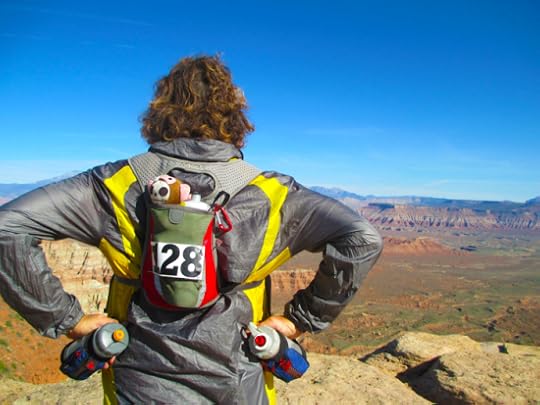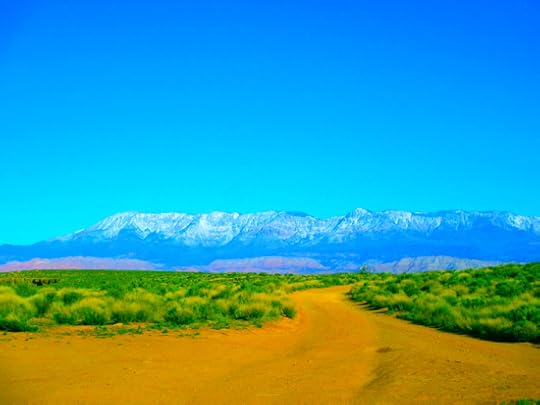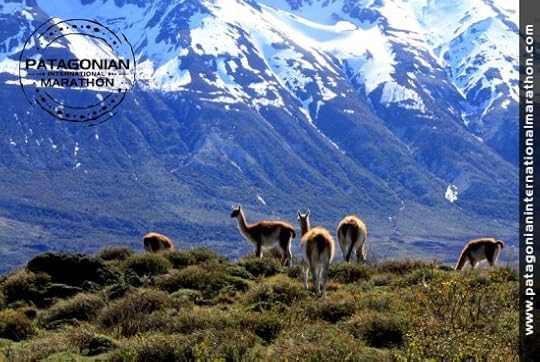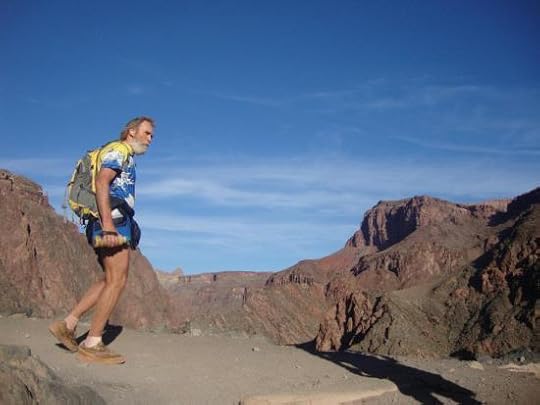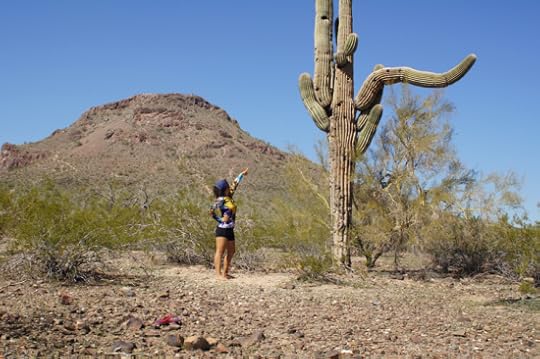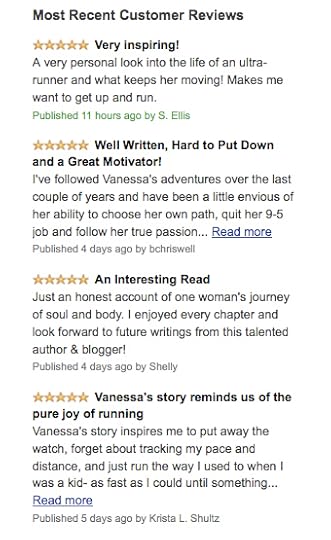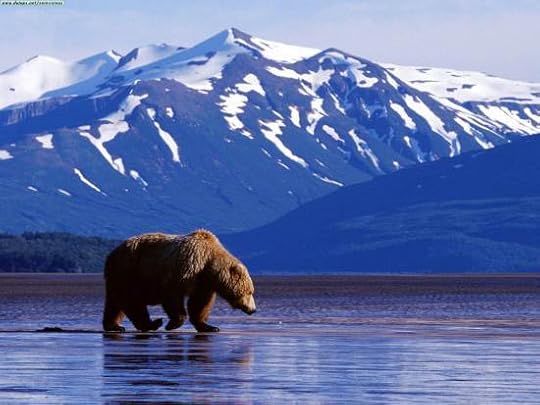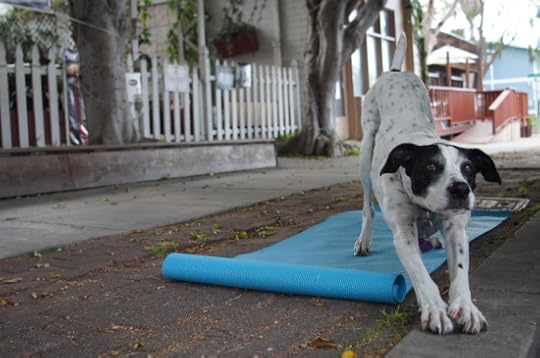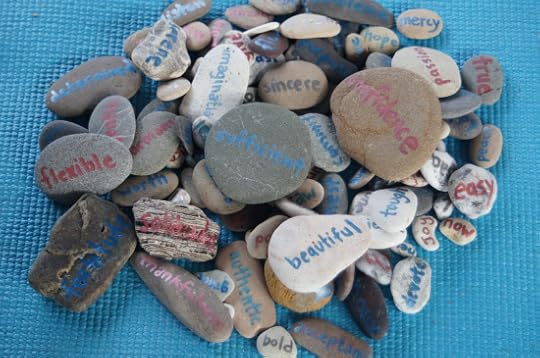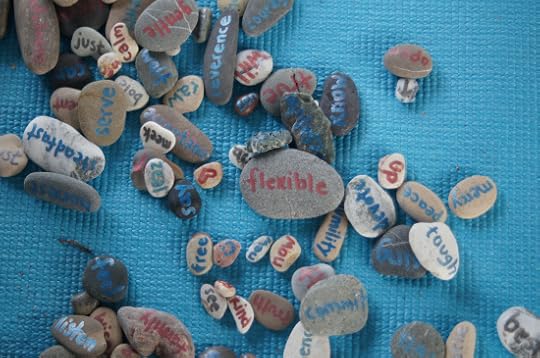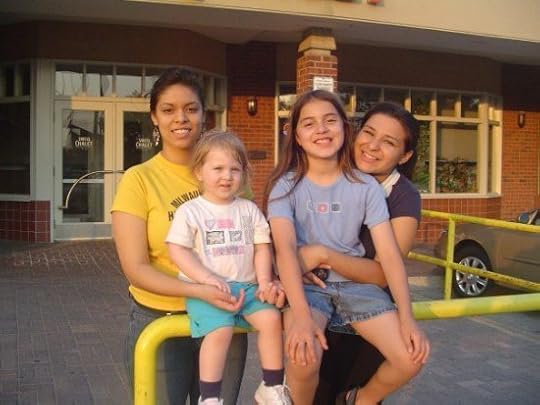Vanessa Runs's Blog, page 17
April 21, 2013
Zion 100 Race Report: Miserable is Memorable
Badwater’s youngest finisher and recent Barkley camp Nickademus Hollon once said: “Miserable is memorable.”
His quote became a mantra for Shacky and me as we neared mile 50 on the Zion 100 course last Friday, but it wasn’t until a couple of days later that I realized just how memorable this race had actually been, how much I had learned, and what a rich experience I had come to know at Zion.
Shacky and I didn’t finish the race. We both dropped at mile 52, though I accused him of having sympathy pains. He argued that he had complained about his knee long before I had, so maybe mine were the sympathy pains?
Either way, I came into the mile 52 aid station limping and leaning on a stick for support. I had tweaked my knee on some slick rock back at mile 30, and the pain kept getting worse until it seemed unbearable at mile 50.
Judging from my recovery after the race, I have no doubt that I would have seriously injured my knee had I chosen to continue. The limping was causing my good knee to slowly give out as I overcompensated.
For the first time in my life, I learned what “bad” pain felt like—the kind of injury that it would take weeks or months to recover from. I wasn’t willing to put in that kind of recovery time. We were headed to Sequoia National Park, Yellowstone, and the Redwoods after Zion. I had to be healthy enough to run among those trees.
The pain I felt in my knee after mile 30 confused me. The course led us down a very runnable, downhill dirt road. I kept trying to break into a run, only to be forced to walk after about five steps due to pain. When I walked, I felt no pain. Finally, I resorted to a speed walk and figured I would just power hike the rest of the way.
At around mile 40, even the hiking started to hurt, and the downhills started to kill. The pain only stopped when I stopped moving.
I wondered if I was just being a wuss, and decided to try an all-out sprinting pace to see what that did. I felt a sharp pain shot up through my knee that made my leg buckle under me. I hopped on my good leg to avoid falling.
People who passed me changed their comments from “Great job!” to “Way to tough it out…”
And at the bottom of Grafton Mesa, the third climb of the race, I sat down on a rock and cried. Why did it hurt this bad? I had never hurt this bad before.
Determined to get to my pacer who was waiting at mile 52, I told myself to pull it together and started climbing Grafton Mesa. On fresh legs, this climb is mostly runnable. Instead, I was inching my way along, limping and grabbing on to rocks to keep the weight off my bad leg. It was pretty miserable, and Shacky gently suggested that I consider dropping at the next aid station—a thought that had already occurred to me.
The idea of dropping felt strange. Other than my knee, I felt fabulous. My other leg felt strong, my nutrition was perfect, and mentally I was ready for many more hours on the trail. I was also, despite the pain, genuinely enjoying the day. The weather was perfect, the course was fabulous, and the race was so well marked.
Inching my way to the aid station, I wondered how dropping would make me feel. I tried to push myself to continue by appealing to my ego. I tried to tell myself that everyone was watching and that I would fail myself and fail my pacers… but I just couldn’t believe that.
I felt—whether I finished or not—like an awesome runner. I had run 100s before, and I would run many more after this. Deep down, I felt strong even though I was limping.
I thought of the Boston batons that the race director had sent out on the course. There was a gold and a blue baton being passed on from runner to runner throughout the course. The batons had the names of the Boston victims, those who would never run again, and would be sent to the families of the victims after they had been carried through the Zion 100.
I tried to motivate myself by thinking about how the Boston victims couldn’t run, so I should run for them. But instead it occurred to me that the greater honor would be to make a decision that would allow me to run again in a couple of days—and for the rest of my life—instead of pushing myself into an injury that would take months to recover from, and then re-occur at every race in the future. How would hurting myself honor anyone?
I thought about how funny perspective is. If this had been a 50 miler, I would be finishing victoriously. But because it’s a 100 miler, I would end the day in failure. And yet the distance is the same. I just ran 50 miles. 50 MILES! Should I really be ashamed?
I felt a distinct shift in my perception of the race. In previous races, I would think of it as: ME vs the TRAIL. But in Zion, the trails feel like my home. We had been here for three weeks, running all these same trails and doing all these same climbs. I knew I could summit and I knew the course would still be there tomorrow. The views were spectacular but familiar, and I just couldn’t see this event as a do-or-die.
When you wake up in the morning, do you race to see how fast you can make coffee? How long you can take to prepare dinner? Of course not—because those are your daily activities. They are your routine. That’s what the trails have become for me. They are my routine and my home. They are there when I fall asleep and there when I wake up. If I can’t run 100 miles today, maybe I can run 50 miles today. Maybe I can run 100 miles tomorrow.
Somewhere along the line, I have managed to detach my ego from my running, looking instead to the journey ahead and knowing that there are so many more trails to run, and an endless amount of miles to cover. I want to run today so I can run tomorrow.
I knew that by dropping at mile 52, I could rest for a couple of days and be back on my feet by the time we got to the next National Park. The other option was to push hard for this buckle, and be out of running for weeks. In my mind, I could imagine the towering trees of the West coast and I pictured them waiting for me. I could smell the moist dirt under my feet, and the soft leaves at my fingertips. It was a no-brainer. I must stay healthy so I could run more—not today, but tomorrow.
The next morning, we drove to the mile 83 aid station, also the home of George and Melissa Walsh. Their aid station theme was “Whiskey Town” complete with limitless drinks and jello shots. Shacky had whiskey for breakfast, and we shared some San Diego IPA.
The Walshes ran such a memorable aid station that the front runners were finishing the course, then driving back to Whiskey Town to party for the rest of the night. Amazingly, they only had one drop there.
Well into the next day, the festivities continued. Matt Gunn had organized a big screen showing of the Western States movie Unbreakable at the local movie theater, followed by a live Q&A with UltrAspire’s elite athletes. After that, it was free burgers and drinks at a local restaurant, and just in case you weren’t exhausted enough, there was also free river rafting.
The running community and volunteers were so warm and inviting that we ended up spending the next day at Tracy and Robin’s house. We talked about aquaponics, checked out their Air Stream trailer converted into a garden, saw some solar LED lights they had made out of Pabst beer cans, and played with their dog and cats.
Memorable is an understatement for what RD Matt Gunn put together this year at the Zion 100. I have no doubt the entries next year will soar. The course is brutally challenging yet still mostly runnable. There was a low-key, small town feel, the marking was flawless, the weather was perfect, and every single finisher’s buckle was handmade.
As we continue to travel the country, I will look back fondly on these memories and do my best to stay healthy enough to run another day in Zion.
You May Also Enjoy:
4 Powerful Lessons From a Nomadic Life
10 Overlooked Rights Worth Fighting For
****
Check out my book: The Summit Seeker


April 14, 2013
Why I Run 100 Milers
It has been two months since I released my first book, and although I have an entire chapter in there about how silly the “Why do we run?” questions is, it ironically has become the most common question I’ve been asked since then in interviews and podcasts. And so I have been forced to formulate a rough answer.
That, combined with the fact that I am now five days away from running my fifth 100-mile race (the Zion 100 in Springdale, Utah), I find myself in an introspective mood, and very much wishing to answer that question for myself.
Why run 100 miles?
There has been some debate going on in the blogosphere as to the value of racing. Why not just enjoy trail “training” runs, without the pressure of a goal race? Why bother with the entry fee, the crowds, the packet pickup? And I can certainly see some validity to those arguments.
I think of my friends like Jason Robillard or Ashley Walsh, who have questioned the sanity of running 100-mile races and have more or less given them up (for now). On a rational level, their arguments make sense. Yet the 100-mile distance still calls to me, whispering my name through sandy canyon walls and from the top of rocky summits.
Over the months, I have seen friends enter ultras and drop out because it was “boring.” This, I don’t understand. A race can be many things for me, but boring is never one of them. When I was a kid, if I ever complained about being bored, my dad would make me do pushups or clean the toilet, so that may explain my aversion to the state of boredom. Plus I can’t shake my father’s voice ringing in my ears: “Only boring people get bored!”
No, I am never bored on the trail.
I think of my friend Christian Peterson who is forever encouraging me to balance my training with Crossfit-ish supplementation, a detour that I have embraced for Zion 100. My mileage decreased in favor of strength work, core work, plyometrics, and even yoga. Though I enjoy when a workout change leaves me expectantly sore, I can’t help but also think of my friend Nathaniel Wolfe who wisely advises: “Stop trying to get in shape. Just do what you love and let your body take whatever shape is best suited.”
What I love is running more miles. Maybe “balance” isn’t the best thing to strive for when training for a 100? Maybe balanced people don’t run 100 milers.
So why run 100s?
I’ve spent the last couple of days of digging through my brain for a list of reasons. I was hoping for a Top 5, or a Top 10 list, but I could only come up with one thing.
Quite simply, I run 100 miles because it’s the only thing I do that demands my all.
Every.
Last.
Ounce.
Of.
Me.
This distance takes from me all that I have, and the thrill of surrendering myself to the trail—to that extreme—is unparalleled.
I was inspired this week by the music of Joe Pug, who seemed to speak to my 100-mile aspirations in his Hymn #76:
“To love me is to sit upon the mountain.
Every step is harder than the last.
But to find a step above it, is to triumph—is to summit.
Taste the frigid water from the tap.”
I need some things in my life to be hard. I need some things to demand more of me—to insist on everything.
Every so often, I need more than a training run. I need to pour all my heart out… in a race like this.
WELCOME TO ZION
Direct YouTube link HERE
****
You May Also Enjoy:
Has Ultrarunning Evolved Past Western States?
4 Powerful Lessons From a Nomadic Life
Answering Patagonia: A Wild Call to an Untamed Land
****
Check out my book: The Summit Seeker


April 7, 2013
Weekly Photo Challenge: Color
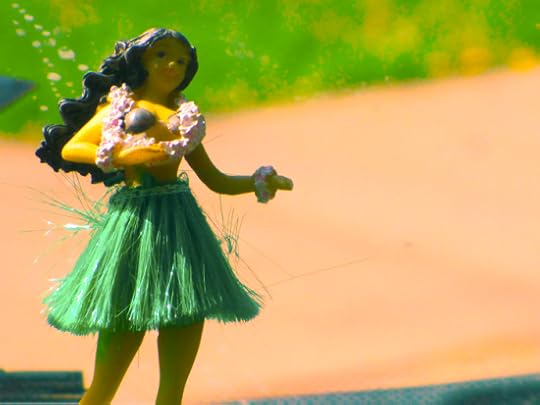
Shacky’s faithful hula girl on the dash of the RV. She has been with him longer than I have.
Here is my second stab at the Weekly Photo Challenge from WordPress. For this week’s challenge, I decided to photograph a gallery of objects focused on one color.
At first I started shooting reds and greens, but then slowly started to realize that all the best things were actually brown:
my kitteh
coffee
hair
mud
dirt
trials
trees
canyons
I was certain my challenge would end up looking like a big blob of poop, but I went with my gut and photographed browns. The photos turned out shockingly lovely, and I’m now seeing my surroundings with a deeper appreciation.
Scroll or click on the photos for captions.
BROWN
[image error]
[image error]
[image error]
[image error]
[image error]
[image error]
[image error]
[image error]
[image error]
[image error]
[image error]
[image error]
[image error]
[image error]
[image error]
And here is my work on the earlier collections of GREEN and RED.
GREEN
[image error]
[image error]
[image error]
[image error]
[image error]
[image error]
[image error]
[image error]
RED
[image error]
[image error]
[image error]
[image error]
[image error]
[image error]
[image error]
[image error]
Thanks for sharing in our travels, and don’t be afraid to put a little color in your life this week!
****
You May Also Enjoy:
Weekly Photo Challenge: A Day in My Life
Has Ultrarunning Evolved Past Western States?
10 Overlooked Rights Worth Fighting For
****
Check out my book: The Summit Seeker


April 3, 2013
Answering Patagonia: A Wild Call to an Untamed Land
Before Alaska and before moving into the RV, there was Noble Canyon. It was while running down this much-loved, familiar trail with my good friend Christine Bilange that my eyes were first opened to Central and South American possibilities.
Christine urged me to not disregard my Central American roots so easily, to reconcile and re-connect with my father and my family in El Salvador, and to seriously consider the possibility of returning south for a cheaper and more natural life.
When my legs are tired, my mind is open, and I had 60ish miles on my legs that week. I went on to run a 100-mile training week at Noble Canyon, summiting every day for five days, and spending several of those miles thinking about what Christine had said. Before that day, I had envisioned myself living in the US for the rest of my life. Why not? We had everything here.
I had even scoffed at Shacky’s suggestion months ago that we look into Central/South American living. “Why would I want to go back there??” I demanded. “My parents worked so hard to get us out…”
But I knew that South American living was cheap, I knew that the land was still rugged and raw, and I felt a strong southern pull on my heart.
“We’re moving South!” I exclaimed to Shacky when I met up with him at the bottom of the canyon. He raised his eyebrows.
Instead, we drove north.
And we continue north—toward Alaska. But the South/Central American seed is still there. Shacky has begun following blogs of American expats who are living full-time in South and Central America. He has come up with places to visit, and spots to camp.
I have begun reading in Spanish and following a blog about El Salvador. We have discussed running across El Salvador (only 160 miles!), and I even had the brilliant idea of running from the northernmost point in Alaska to the southernmost point in South America. This would take us three to four years, but Shacky still needs some convincing (maybe include the PCT?).
This month, my dad is in El Salvador looking into charities and logistics to support a run across that country (this would be the first time it has ever been done). He’s doing the legwork as far as security and supplies, and I’m back in touch with him after almost two years of silence.
Many weeks after Noble Canyon and Christine, I found myself sitting in a Volkswagen dealership in Arizona when a Skype call from Nick Barraza came in. He wanted to talk about the Patagonian International Marathon (ultra distance available), the conservation efforts in Chile, and the Patagonian Ambassador Program. His timing was impeccable.
Listening to him describe Patagonia, I knew we had to go there. Nick took me on as a Patagonian Ambassador and I got this lovely profile page, alongside some awesome names like Krissy Moehl and Dylan Bowman. I am truly honored.
But what excites me the most is Nick’s descriptions of the conservation efforts in Chile, and the mountains there. I have a vision of us spending several months in Chile, working first-hand for this cause, and running those mountains.
I asked Nick for an interview to try to express the lure of Patagonia. Perhaps you will also feel drawn to this wild land.
Interview with Nick Barraza
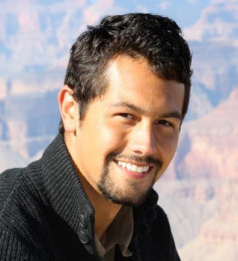 What is it that calls you to Patagonia?
What is it that calls you to Patagonia?
As with any natural area of beauty and wonder, Patagonia speaks to the adventurer in me. The biodiversity, pristine lakes, breathtaking glaciers, and majestic rock formations make this region extremely special. In short, my inner-coyote howls for Patagonia.
How did you get involved with this race?
Now that is a long story! After completing the inaugural marathon in 2012 I had accumulated a handful of ideas along the run. Wanting to aid Nomadas International Group SA (NIGSA) in their quest to promote and aid conservation in the Patagonian region, I initiated contact with the company and offered my support and work in any form possible.
What do you hope that runners will gain from this experience?
I hope runners are inspired to come down to Torres del Paine, Patagonia and partake in this collective and international effort to spread education and inspiration around the conservational efforts taking place throughout region.
Runners will not only be able to see one of the earth’s most precious landscapes, but also dip their feet into Chilean and Patagonian culture. This event connects local Chilean runners with runners from all around the world and brings people together to celebrate the culture and preservation of Patagonia.
How have you been involved with conservation?
Studying and researching as an Environmental Scientist has always led me, in one way or another, to a conservation project.
However, it was not just my degree and path of study that led me to participate in various aspects of local and global conservation. In fact, most of my involvement with conservation has been through volunteering within local communities.
What is your favorite memory in Patagonia?
Ah, now this is wonderful question, and a very special one too! As a result of running the race in Torres (and a long story to follow), I met my amazing girlfriend and partner in crime in the heart of Patagonia.
Little did I know that three months after the race we would both end up leaving our respective jobs to set out on a three-month backpacking excursion through Chile, Argentina, and Peru.
Our journey changed my life in ways I would have never thought possible. The magic of Patagonia is responsible for harboring our initial connection and for that I am eternally grateful.
What is your favorite Patagonia wildlife and why?
Well, I am a big fan of foxes, that’s why I have a dog that looks just like one! However, I am going to go with the region favorite on this one and say guanacos. Let’s just say they have very intriguing personalities and tend to showcase these personalities through spitting at passing trekkers. They are very amusing creatures! Google them!
Besides attending the race, how can people get involved?
For people that cannot make the event, we invite you to join us in our quest to spread education on the sustainable initiatives taking place in the Patagonian region. Connecting with the event on Facebook, Twitter (@PatagonMarathon), and helping us share and promote the race and organizations the event supports.
Also, we invite anyone and everyone to post blog entries, pieces in magazines, local newspapers, etc., to help get the word out there. If you do decide to do this, please let us know, so we can feature your piece on our site and social media networks!
We have also created the Patagonian Ambassador Program. Which seeks to partner with runners, writers, filmmakers, and any one else who is inspired and passionate about our event and conservation in Patagonia. You can view the program HERE.
If you are interested in becoming a part of this amazing team of ambassadors please get in touch with us at info@patagonianinternationalmarathon.com
Patagonian International Marathon Video
Direct YouTube link HERE
****
You May Also Enjoy:
4 Powerful Lessons From a Nomadic Life
Seeking Dispensers: A Call to Embrace a Wild Life
****
Check out my book: The Summit Seeker


April 2, 2013
Has Ultrarunning Evolved Past Western States?
On April 1st, the eyes of ultrarunners across the country lit up when they read about the drastic changes to the Western States 100 course. You can read the article on irunfar here: Western States Announces Changes.
Minutes (hours?) later, hopes were shattered when runners learned the article was actually an April Fool’s joke and Western States was still same old, same old.
But the real joke, it seems, was on Western States.
Tracking the excitement around the changes, followed by the let-down of the prank, I wonder whether ultrarunners are begging for a real change.
The article proposed changes that would make the course harder, the most popular change being a hard 24-hour cutoff.
Western States’ own godfather Gordon Ainsleigh famously ran the course for the first time in under 24 hours, and was thrilled with the new “changes”. His Facebook post:
“It’s great to be a part of this epic improvement in the race I started… It’s finally getting back to the way it was when I did it in 1974: Just 3 aid-station/crew-access points… About time!”
His comment when he found out it was a joke?
“Oh, shift! Was it all a tragicomic dream?”
Jokes aside, Ainsleigh actually has some realistic and innovative ideas to make the race:
a) harder
b) guaranteed entry for everyone
c) more accessible to 55+ seniors
If even a stubborn old man like Gordy knows it’s time to evolve the race, perhaps it’s time we listened.
Yes, Western States has the historic appeal. Yes, it has the hype and the hoopla. But are runners starting to say this is no longer enough?
Sherpa John wrote a great post on his Western States experience that actually made me think that I never want to run it. You can read it here: Western States Thoughts
I entered the WS lottery for the first time last year, secretly hoping that I wouldn’t get in. We had plans to spend the summer in Alaska, and Western States would have conflicted.
Still, it seemed that entering the lottery was the thing to do and I couldn’t be a “real” ultrarunner unless I threw my name in like everyone else, never mind that I have five buckles sitting in the RV.
I realize now how lame this was and I’m relieved I didn’t get in. I doubt I’ll qualify or enter the next lottery. What bothers me the most is that the races I want to run aren’t qualifying races, yet they’re much harder than the qualifiers.
I have my eye on a 100-miler in Alaska this summer and I’ll be running Zion 100 in three weeks (neither are qualifiers). I ran the last Chimera 100, and was shocked to learn that although it was not a qualifier, the Old Goat 50 (exactly half of the Chimera course), was. It makes no sense.
The races I seek out are newer, grassroot events. So my chances of qualifying are pretty low, even though I’ll end up with some rock hard mountain miles under my belt.
I haven’t been around this sport long enough to have an expert, informed opinion. But I do know what ultrarunning means to me. It’s not about the politics, hype, and drama of Western States.
It’s certainly NOT about entering a race because you’re “supposed” to.
It’s about community. It’s about mountain solitude. It’s about accessibility for all who are crazy enough to attempt a race. And if a race can’t be accessible to everyone, it better be extremely hard.
I’m curious about where others weigh in on this. What are your thoughts?
Check out the Facebook discussion HERE.
****
You May Also Enjoy:
Ultrarunning Through 2012: Point Form & Video
10 Overlooked Rights Worth Fighting For
****
Check out my book: The Summit Seeker


April 1, 2013
Weekly Photo Challenge: A Day in My Life
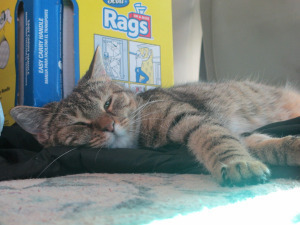 Last week I was inspired by the weekly photo challenges on WordPress.com, and decided to give one a try. I had a blast today documenting a day in our lives. The challenge was to take one photo every hour as you go about your day. I took a little bit extra, but at least one photo every hour.
Last week I was inspired by the weekly photo challenges on WordPress.com, and decided to give one a try. I had a blast today documenting a day in our lives. The challenge was to take one photo every hour as you go about your day. I took a little bit extra, but at least one photo every hour.
So often I try to express through words what our lifestyle is like: living in an RV, bumming around, eating, running, writing, and reading. I’m a word girl, not a picture girl. So this was the perfect challenge to help me think outside the box, and I gained a new perspective on what it is we really do all day.
I found my inspiration renewed with this experience. I could write a post about every single one of these pictures (hover or click on the photo for a caption). One picture truly is worth a thousand words.
Welcome to our Monday.
[image error]
[image error]
[image error]
[image error]
[image error]
[image error]
[image error]
[image error]
[image error]
[image error]
[image error]
[image error]
[image error]
[image error]
[image error]
[image error]
[image error]
[image error]
[image error]
[image error]
[image error]
[image error]
[image error]
[image error]
[image error]
[image error]
A lovely end to a day well played.
You May Also Enjoy:
4 Powerful Lessons From a Nomadic Life
Poems for Travelers and Future Explorers
Alaska-Bound and Other Adventures
****
Check out my book: The Summit Seeker


March 21, 2013
10 Overlooked Rights Worth Fighting For
As a Canadian living in the USA, one of the first things I noticed upon moving here was how gung-ho Americans seemed to be about fighting for their rights. Issues like gun control, health care, and other common themes are sure to raise blood pressures and trigger heated debates.
Yet the greatest inhibitions in life are the ones we place on ourselves, and that has certainly been true for me. These past few months I have been attacking the obstacles that have been preventing me from embracing true freedom, and I’ve discovered that these are rights many of us have overlooked. And unlike many major political issues, these things affect us every day, several times a day.
Exercising the following rights has freed me in many ways, and I hope they will also inspire you to live better:
1. I will exercise my right to take my time.
Do you know what the worst part of a minimum wage job is (I’ve had several)? It’s not the crappy hours or the pathetic pay. It’s the 30-minute lunch breaks. Lunch in 30 minutes?! That’s unheard of. I’m a one- to two-hour lunch girl. I’m also a slow eater.
I’m slow at chewing. I’m slow at swallowing. And when I’m done, I’ll probably want dessert. God help you if I make tea—I’ll just sit there sipping until the sun goes down.
When I lived in Mendoza, Argentina, I quickly adapted to their European model of eating lunch. Everyone went home at lunchtime, prepared lunch, took their sweet-ass time eating, and then took long naps. They went back to work at around 3 p.m., and worked until around 7 p.m.. Now there’s a decent life.
The truth is, I’m slow at most things. I’m a slow runner. I’m slow at waking up. And I’m slow at thinking my thoughts and writing them down.
But I like to think that these things are worth the wait. Great things need time to just sit around, like wine or sauerkraut or cheese (more about cheese later). Slowing down also gives me time to make sense of my world, and write posts like these.
Ever since I left the corporate world to bum around the country in an RV, I’ve been less apologetic about taking my time. I’ve exercised my right to move slowly. As a result, I’ve noticed a drastic boost in creativity. I get more and better ideas. My thoughts have time to develop and intertwine. I write better, with more clarity, and I can make better connections.
If you operate in a rushed environment, I strongly encourage you to slow down. I was always afraid to try this, especially at work because everyone around me was moving so fast and I worried I would get left behind. But I wish I had been brave enough to slow down sooner. I would have been better at my job, better at relationships, and better at life.
Practice saying these amazing phrases:
“I need more time.”
“I’m not finished with that yet.”
“Please come back later.”
And every once in a while, take a long lunch. A REALLY long lunch. Make a cup of tea and drink it slowly with a friend. Yes, life is short. But these are the simple pleasures that make life worth it.
2. I will exercise my right to sing and/or dance.
A few weeks ago we were shopping at Trader Joe’s. Shacky was looking for some eggs and I found a little corner where they were giving away cheese samples. CHEEEEESE!! I love cheese, but I’ve been on a mostly-vegan diet since May (plant-based is a more accurate description). It was really good quality cheese though, so I decided to make an exception and try a sample.
I hadn’t eaten cheese in quite a while and it was so freaking good that I wanted to hop up and down and do a little dance. But I didn’t. Cause I was at Trader Joe’s and it was crowded. But I should have.
This wasn’t the first time I suppressed a little dance. I usually feel like singing on the trails, but sometimes Shacky says, “Do you really have to sing This Land is Your Land again??” Still, I don’t want to suppress stuff anymore. If I’m happy, I should do a little jig.
I love cheese.
3. I will exercise my right to make a joke.
When I was trying to be a cool kid back in the age range when being cool was important (Jr. High), Yo Mama jokes were in style. So were any other insult-jokes.
Like this:
Yo mama is so stupid that it took her two hours to watch 60 Minutes.
What’s the difference between three penises and a joke? Your mom can’t take a joke.
Learn from your parents’ mistakes—use birth control.
I loved jokes. I would go to the library to read joke books, but they weren’t insult jokes. My favorite joke of all time was this:
Q: Why was the math book sad?
A: Because it had so many PROBLEMS!!”
HAH. Still a damn fine joke.
But I never got to tell it. Because the exchange below never quite seemed like a natural flow:
Other kid: Yo mama is so fat that when she gets in an elevator, it has to go down.
Me: Why was the math book sad?
As the years passed, I never really grew out of my silly sense of humor. I always had a quirky funny bone, and I would often find myself laughing alone at things that nobody else thought were funny.
I grew up with a sarcastic and teasing sense of humor. In my family, if someone teased you until you cried or until you became raging mad—that meant that they loved you. I have vivid memories of my dad making me cry this way. I can’t say I always enjoyed it, but his sense of humor did seem to rub off on me.
My uncles were the same way. They would torment each other, and that was how they showed love. But at school, they called that bullying.
In Junior High, I had a good friend that I teased in music class one day. I told him that his new haircut made him look like he had cancer. My teacher heard me, and lost his mind. He threw his music stand across the room, screamed at me, and made me leave the class. I was shocked. What did I say?
At that time, my mom was dying of leukemia and it was actually something we joked about at home. Humor was a coping mechanism and I genuinely had no idea that cancer was a sensitive issue.
After that outburst from my music teacher (who I loved and admired), I learned to heavily sensor my humor. Even now, I have a sarcastic, dirty, and hard-hitting funny bone. I still sensor myself a lot.
But I’m learning to let go. To just be who I am, even at the risk of offending others. Yes, I can seem callous and inappropriate. But there’s something to be said about humor as a tool for healing. We are hurting, but it hurts less if we can joke about it. We are starving, but our stomachs can be filled with laughter.
One of my biggest reliefs in life is when I hear someone else make a highly inappropriate joke that I also think is funny. The realization that they have the same sense of humor—and that I can be myself with them—is so liberating.
I can tease others mercilessly, but I can also roll with the hardest of jokes when they are directed at me. The best thing in life is to be able to laugh at yourself. And when someone laughs at me—I still feel loved.
Last month, I took Shacky to meet my uncles in L.A. I was a little worried because I didn’t know how they would act around Shacky. As soon as they opened the door, the first thing they did was tease him about his beard. And they continued to do so for the rest of the night, as new beard jokes occurred to them.
To me, the thought of teasing someone immediately after meeting them, before “feeling them out”, is a huge risk. I think twice. But to see my uncles do it so naturally, I had to smile. They were being themselves.
4. I will exercise my right to look you in the eye.
“EX-CUUUUUSE ME! Do you have a staring problem??!!”
This was said to me by a snarky little black girl in my elementary school class. She scared me a little. But she was right—I had a staring problem. I like to look at people.
What can I say, people are pretty interesting. Faces are cool. But direct eye contact was considered rude.
Don’t look at strangers.
Don’t stare.
Keep your eyes to yourself.
All of these were things I was taught in school and in other social settings. So I stopped looking. Until eye contact seemed weird and uncomfortable. I lost my childlike courage to stare.
But I don’t really believe staring is a problem. I think I have a right to look you in the eye. You left your house this morning. You went out in public. We’re in a public space. So I believe I can look at you quite freely. I can wonder about you or think you’re pretty, or admire your clothes. And who knows, I may even say hello.
I’m tired of averting my eyes. I want to see you and notice details about you, and maybe even recognize you the next time we meet. And if you look back, maybe we can share a smile.
5. I will exercise my right to be silent.
My ex-boyfriend was a talker. I was always more of a listener, so I learned to perfect the art of acknowledgment-noises. Like:
“Yes.”
“Hm.”
“Uh-huh.”
“Interesting.”
Shacky doesn’t have any acknowledgment noises. So when I tell him something, sometimes he doesn’t reply at all. “Did he hear me?” I wonder. So I tell him again. No response. Again?
Eventually he just says, “I wish you’d be quiet.” And I have to laugh.
He DID hear me. But he exercises his right to be silent, and I’m learning to do the same.
Sometimes when I’m running in a group, I feel pressure to talk. It’s pressure I put on myself, thinking I have to fill every silence or people will realize I’m actually pretty boring to run with.
But silence is awesome, and I have a right to shut the hell up. I don’t have to make shallow, meaningless acknowledgment noises. I don’t have to rack my brain for something to say. I can just listen and talk when I want to.
Silence doesn’t mean that I’m mad. It doesn’t mean there’s something wrong, yet often that’s what we assume. We think everything is cool as long as someone is gabbing.
In journalism school, one of my professors gave me a valuable tip that I never forgot. I’ve used it often with tremendous results. It’s this:
When you’re interviewing someone, ask them a question and let them reply. After that, there’s a lull. A short silence. The interviewer’s instinct is to fill this silence with a response, or by asking the next question. But if the interviewer is brave enough to remain silent, the interviewee will start speaking again. They will answer the question a different way. Because they’re out of their standard reply, what they say next is usually genuine, raw, and often the blatant truth. More often than not, they reveal something truly insightful and fascinating in an effort to fill that silence.
My professor was an expert with this technique, sometimes staying silent long enough for the interviewee to provide two or three answers. The key is for the interviewer to be comfortable with silence. They must perfect the ability to look at someone and just smile, knowing that they are waiting for you to say something, but refusing to utter a word.
I have been trying to eliminate wasteful words from my daily life. I want to stick to words that come from the heart and that mean something. Words with intention.
And if I have nothing to say—I will exercise my right to say nothing at all.
6. I will exercise my right to get excited.
Getting excited is never cool, especially when you’re a teenager. As a teenager, I would get excited about most things, so I was a pretty big nerd.
I would get excited about books, about nature, about learning, and even about homework. I would wonder how things were made, and I would get excited about that too. The cool kids were indifferent and unimpressed. That’s what made them cool. They would roll their eyes at me, so eventually I learned to stop showing my excitement.
I still get excited about a lot of things, but I’ll also still catch myself suppressing my excitement (see section above re: cheese dance). It’s a bad habit formed over time that I need to shake off.
I miss getting really excited about stuff. I miss jumping up and down and clapping my hands. I miss high-fives. I miss lingering at a rock formation or a sign, to examine them thoroughly and then get excited about them.
In my mind, I still see the rolling eyes of those judgmental teenagers, even though they’re no longer part of my life. It’s time to exercise my right to excited about dumb stuff.
7. I will exercise my right to experiment.
Jason Robillard has just written a book (to be released soon) on trail and ultrarunning. He calls it a “Guide for Weird Folks” because it contains a plethora of lessons and experiences he has accumulated over years of experimentation and doing the opposite of conventional running wisdom.
As a result, his book is full of tips that you will not find anywhere else. Jason has experimented with various forms of sleep deprivation training, stomach training (how to run on both a full stomach as well as an empty one), and even when it’s best to wear cotton instead of tech clothing. He has done everything from running in a sun hat to duct taping his gonads (sans instructional video). He even covers grooming in the nether regions for endurance runners (hair, no hair, or some hair?). It’s quite a read.
The success of Jason’s blog, and the pending success of his book, is a great example of the power of experimentation. I’m a big fan of guinea-pig-style writing, and I’m strong advocate of experimentation.
It used to be that ultrarunning was such a niche sport that participants HAD to experiment to find what worked for them. These days there is so much written about training and race tips, that you could easily follow conventional wisdom and, in my opinion, miss out on valuable knowledge.
Our society isn’t set up to encourage experimentation. We are consumers of the tried and true. We want someone to tell us what works so we don’t have to try new things. But experimentation is still the best way.
My ultrarunning experience can be summed up by stating that I’ve had great success by doing all the wrong things. I increased my distance too fast. I don’t taper. I almost always try something new on race day, including shoes. One thing that experimentation teaches me is the incredible skill of adaptability.
And really—what is an ultramarathon finish if not a successful adaptation to all the challenges faced throughout the day? Experiment, experiment, experiment. In this sport, there are no rules—same with life.
8. I will exercise my right to do my best.
“Our deepest fear is not that we are inadequate. Our deepest fear is that we are powerful beyond measure. It is our light, not our darkness that most frightens us. We ask ourselves, Who am I to be brilliant, gorgeous, talented, and fabulous?… Your playing small does not serve the world. There is nothing enlightened about shrinking so that other people will not feel insecure around you… As we are liberated from our own fear, our presence automatically liberates others.”
– Marianne Williamson
This is a quote that resonates with me. Often, I seem fearless on the outside. But my deepest fears are rooted in the fact that I’m afraid of what I could become if I did my absolute best.
It all started in elementary. I would do well in class, and get labeled a nerd. So I learned to hold back. I learned to do well, but not too good. I learned to never do my best.
When I started running ultras, I quickly learned that I was pretty good at it. I ran my first sub-6-hour 50K early on in my ultra career. I jumped from the 50K distance straight to 100 miles. I finished 100 miles on my first attempt. And in that same year, I finished four 100s.
Even so—I still hold myself back. During races, if I’m running fast and feeling good, I think:
I shouldn’t feel this good. Something must be wrong. I should slow down.
I don’t deserve to finish this strong. I should move slower.
People with more experience are further behind me. I should slow down.
I’m not hurting, but everyone else is walking. I should walk too.
I’ve had a really good running year. I should finish this, but not push too hard.
Deep down, I’m afraid of what I could become if I truly did my best. Like that elementary student, I want to do well but not stand out. I’m terrified of my limits. Not because they will hold me back, but because I may discover that I actually have none.
Little by little, I’m conquering those fears. I’m signing up for harder mountain races. I’m starting to expand my training: more core and strength work, with the purpose of getting stronger. I’m experimenting with more uphill running, instead of just power hiking. It’s a slow process, and sometimes I’m still very afraid. But I know that I don’t have to measure myself by anyone else’s standards. I can do my best, and soar to new heights.
And yes—I do deserve it.
9. I will exercise my right to fail.
From an early age, we set up our children for success. We try to give them every advantage, every head start, and the smoothest road possible to an easy and profitable life.
But don’t we learn better from a face full of dirt after a hard fall? From scrapped knees and bloody hands and hot tears? We learn from our failures, and we learn fast.
That’s how I grew up: with the face-full-of-dirt technique. That’s how I learned to ride a bike, to run on trails, to attack life’s challenges. Yes, some things were harder, like fitting in at school, but there was one thing I learned from growing up this way that has brought me great success: I lost my fear of failure.
I’m not sure it’s after your 100th time, or after your 1000th time of failing that you lose the fear of failure, but eventually it does go away. Failure just becomes a way of saying to yourself, “Try again another way.”
I have said before that when I registered for Chimera 100, I knew deep inside that I could not finish it. I embraced the possibility of failure, and started training my ass off. Had I been terrified of failure, I never would have registered. I never would have finished.
You know that feeling right after you register for a race, or take on a huge task where your blood pressure starts to rise and you think, “Dear God, what have I just done??!!” That’s good. That means you’re exercising your right to fail.
At my second 100-mile attempt, I failed. It was Nanny Goat 100. I only made it to 55 miles, and I felt pretty dumb because it was supposed to be an “easy” course. But the course was a 1-mile loop, and after 55 miles, the loops really got to me. I just gave up mentally. I just didn’t care anymore.
I learned so many things from that failure. I tried a few more looped courses, like Across the Years 72-Hours (1-mile loop for 3 days), and confirmed what I learned at Nanny Goat: I’m not really built for these types of courses. Give me mountains. Give me water crossings. Even give me mountain lions, rattlesnakes, and bears. But if you give me a loop where I’m going nowhere, I’ll want to shoot my brains out.
I still love the challenge of looped courses and greatly admire the folks who can buckle up and knock them out, but my failure at Nanny Goat taught me what my strengths were.
Failure is a shortcut to learning. The greater the failure, the stronger the lesson is reinforced. Embrace it.
10. I will exercise my right to dream ridiculously big.
“What the hell are you trying to do, run 100 miles someday??”
The biting words of my ex-boyfriend still ring in my ears. His tone was one of such deep disgust, and I knew he meant for me to be offended at his suggestion. It was right after I had come home from a long run, and he couldn’t understand why on earth I needed (or wanted) to be out running all day.
But I did want to run 100 miles. And how do you even begin to explain that to someone?
In life, I have learned that there are dreamers and there are dream-killers. Associate with dreamers.
Dreamers will not care WHAT your dream is or how ridiculous it sounds. They think you can do it, and will cheer you on.
You want to run a 50K on little training, Trisha Reeves? Oh ya, you totally got it.
You want to run across the country with no money and no shoes, Patrick Sweeney? Easy peasy. Go for it.
You want to backpack across Central America by yourself through dangerous places, Jess Soco? Totally doable.
It doesn’t matter how ridiculous your dreams are, or if they’re even about running. Dreamers will cheer you on. That’s because dreamers know just how possible the impossible really is. And they’re often right.
Despite what others think of your skills, capabilities, or experience: You have a right to dream big. Not just a little big. Ridiculously, that-makes-no-sense, you-must-be-insane big. The kind of big that everyone—except for dreamers—will scoff at.
It’s your right to hold on to your dream. To nurture it, protect it, and grow it.
I threw myself unreasonably into my first 100-miler after only a small handful of 50K finishes. It was senseless and crazy and unheard of. But the dreamers in my life said: “You want to race 100 miles after only a few mediocre 50K finishes? You can do it.”
And so I did.
I have to smile whenever I read ultrarunning how-to articles that caution you on going slow, staying safe, and “never do anything new on race day”-type advice. Of course, this is all very reasonable advice. I cannot deny these tips, and it is your right to follow those wise words.
However, it is also your right to take a huge chance. To be reckless and completely crazy and just dream big. Really really really big.
You can do it.
***
YOU MAY ALSO ENJOY:
Seeking Dispersers: A Call to Embrace a Wild Life
East Jesus in Slab City: Finding Community in the Desert
Alaska-Bound and Other Adventures
***
CHECK OUT THE SUMMIT SEEKER HERE:


March 6, 2013
4 Powerful Lessons From a Nomadic Life
I am writing this from a picnic bench at Thunderbird Conservation Park in Glendale, Arizona. I’m surrounded by hills, littered with trails going in all directions for many miles. My dog is lounging under a tree, exhausted from some hearty ball play this morning. She snoozes with one eye half-open, just in case I get up for an unscheduled run. I can see mountains in the distance.
The sky is overcast and the weather is pleasantly cool—a refreshing breeze, yet it’s warm enough for just a t-shirt and short shorts. That’s what I’ve been wearing all day. I wore this at my raw vegan breakfast, during a one-hour solo yoga session at the trailhead, and for my long walk with the dog.
Now I sit and type, hugged by nature, and I reminisce on what has brought me to spend an entire Tuesday (as well as yesterday’s Monday) bumming around at this particular trailhead, with no tasks other than to feed my mind and empower my body in whichever way I please.
I have already written many words on how Shacky and I moved into an RV and gave up our jobs to travel, run trails, and in my case—write my first book. But now we’ve been on the road for several weeks. My book has come out, it’s doing great, and I’ve started my next one. In that time, there have been many concepts that have shifted my perspective on the world, and there is value here for everyone—whether you live in an RV or not—to make small changes and enjoy a life that is just a little bit more awesome.
Here are some secrets I’ve gleaned from my still-new nomadic life:
1. Uni-tasking
Back in the “real” world, when I had a job and a house, I found myself multi-tasking constantly. It was my only chance at completing my lengthy list of chores and responsibilities.
At work, there was no down time. The daily tasks (checking email) were overshadowed by the weekly tasks (writing, editing), which were overpowered by the monthly tasks (preparing reports and keeping those page views rising). Month after month, the tasks repeated themselves.
At home, there were chores like dishes and laundry and dinner and cleanup, which had to be attended to immediately if they were to be completed before bedtime. The repetitive cycle was never-ending, and only served to keep the house in working order, like a hamster wheel that turns round and round but never advances anywhere.
Moving into a 22-foot RV, 97 percent of my previous To Do list was eradicated. There was no office to spend my day in. There was no house to maintain. In place of my To Do list, I formed a Project List. These were not tasks that repeated on a daily, weekly, or monthly basis. These were big ideas and huge projects that would take months—years, even—to see through. For the first time in my life, I had the time to slowly chip away at these dreams, and set them into motion.
The first big project I tackled was writing my first book, The Summit Seeker, a task that took me nine months to complete. Besides writing my second book, other things on my Project List include:
PCT thru-hike
Run across El Salvador (approx. 160 miles)
Spend a summer in Alaska
Live in Slab City for one year
Run across America
Live and work at a farm for one year
Live and work at a wild animal sanctuary
Summit all of Colorado’s 14ers (mountains reaching 14,000 feet)
I no longer multi-task. I don’t have to. I have the time to sit and spend hours, or a day, or a week, completely immersed in one project that interests me. The progress I’ve seen from this uni-tasking is mind-blowing, and cringe to think of how many of us have big ideas on the back burner while we desperately try to cycle through the smaller, meaningless chores of daily life.
Call to Action Challenge
Set aside one hour of each day to pursue your personal projects. You probably already have one in mind. It’s that one thing that you’ve been meaning to “get to” when your schedule clears up. Guard this personal time fiercely.
Neglect your daily chores if you must and follow the natural flow of your curiosity. Did you read or see something that you want to learn more about? Follow that trail all the way through. Yes, it may lead to a rabbit hole or a dead end, and that’s okay. Pursue your interests, even if you start by staring off into space, just pondering.
Accomplish something that won’t have to be re-done in a week or a month. You don’t have to change the world, but maybe you will learn a new instrument, pick up a new language, or write a book.
2. Authenticity
When I was working in an office, I got called to my supervisor’s desk one day and asked to put on my shoes. Because I worked behind my own desk all day and because I never had comfortable business shoes, I would kick them off under my work space. Nobody would notice, but once I forgot and walked to a meeting two doors down the hall in just my socks. I got in trouble.
In my old life, there was professional-Vanessa and there was play-Vanessa. There was the Vanessa who dressed business casual and went to meetings, and there was the Vanessa who played on the trails and acted silly with the dog.
One of the first things I noticed after moving into the RV was that most of my Vanessas evaporated. There is only one Vanessa now—just me. I didn’t have to wear dress shoes or wear a meeting-face. I was no longer expected to look or act a certain way. I could be myself.
I began to rediscover myself, and I learned more about what I loved and disliked. Getting comfortable in my own skin gave me a newfound confidence. I stopped second guessing my dry and sarcastic sense of humor (Would the office folks get offended?), and I stopped censoring my opinions (Was this the appropriate crowd to express my true views?). I regret with all my heart every second of my life I spent trying to fit into a mold that was not me.
Call to Action Challenge
Go 24 hours straight just being yourself. Genuinely and fully. Be the same person at work that you are at home, that you are on the trails, that you are deep inside. You will be surprised at how much you can get away with. Once you’ve mastered that, go for three days. One week. One month.
Catch yourself every time you’re trying to be someone or something else. It will take time, and yes you will offend some people with your ridiculous views and obscene sense of humor. But keep at it. You’ll slowly weed out all the people who shouldn’t be in your life, and those who can truly love you will be drawn your way.
3. Sufficiency
A few weeks ago, the thermostat in on our RV fridge broke and we lost the ability to store food there. It would either get very warm or completely freeze, and all our food went bad. We shut the fridge door and started doing what I thought was impossible: living and eating well without a fridge.
I instinctively switched to a mostly raw vegan diet, but the most drastic change of all was the shift in my perspective on sufficiency. Our fridge is tiny, so it’s far from what most people would call abundant. Anyone could see that we were already living minimally… but were we really? With the fridge, it was easy to buy a little extra. Sometimes we’d throw extra food in the small fridge until it went bad.
Now, by force, we eat day-to-day. We buy what is truly sufficient. We know that if we can’t eat what we have today or tomorrow, we’ll have to throw it out. We have one box where we keep fresh fruits and veggies like oranges and cucumbers, as well as another microwaved-sized drawer to keep everything else. Here we keep soups or pasta or canned beans. And that’s all the space we have.
It sounds restricting, but the fridge-free experience has been liberating. It has freed my mind to think in terms of the present, and not worry about what I will eat the next day. This has challenged my fears about the future, and focused my energy on doing the best I can today.
Call to Action Challenge
Go three days without using a fridge. This is tough to get your mind around, but easier than it sounds. At the very least, it will improve your awareness of exactly how much you need to eat every day and how much food is actually wasted. Anybody can get through three days. A lot of food, you may be surprised to find, does not actually need to be refrigerated, especially if you’re eating it that same day. Eat fresh food while it’s fresh.
4. Hospitality
Do you know that feeling when you have guest over, and you sense that they genuinely enjoyed their time with you? They loved your food, they were refreshed by your conversation, and they benefited from your comforts and amenities. Serving them made YOU feel good. I was always taught to take in strangers, and help travelers. But these days, how many strangers and travelers really cross our paths?
After leaving our home, Shacky and I became those strangers and travelers. And the hospitality we have experienced has blown us away. People WANT to help us. They want to share their showers, laundry rooms, food, beer, wine, pools, hot tubs, and homes. As much as we have gained from this unexpected hospitality, I always come away with the sense that these families were just as refreshed by treating us well.
A highlight for us this week was visiting Hannah and Jay. We were strangers to them, but Hannah read my book and invited us over for dinner, sight-unseen. We knew nothing about them, but we ended up loving their company—they had some amazing reptiles, and shared many of our interests. It turns out that Hannah is from Alaska, and we hope to see her there again this summer and meet her family.
How often, in this day and age, do we invite complete nomadic strangers to our home for a meal? True hospitality is still as magical as it always was, and we’re missing out.
We don’t give people enough opportunities to help us. In a world where everyone has everything, hospitality is a lost art. We all have enough to make our own dinners. We can swim in our own pools. We can use our own amenities. But when you put yourself in a place of need, even in a small way, that spark—that desire in others to help—is ignited.
Even harder than offering hospitality is receiving it. We like to be independent and self-sufficient. It’s hard to put yourself in a place of need, and even harder to ask for help. Yet Shacky and I have seen the joy and satisfaction that others feel when they are able to help us.
Call to Action Challenge
Put yourself in a place of need. You don’t have to become homeless, but put yourself in a position where you can benefit from the help of a friend or a stranger—and ask for that help. This can be as small as borrowing a book, a kitchen item, or asking for a batch of cookies that your neighbor is so good at baking. Don’t pay them for it, but genuinely and fully appreciate it.
This sounds douchey, but I guarantee it’s a beautiful exercise. You are allowing someone else to help you, and you’re putting yourself in a place of vulnerability. Of course, that person is free to turn you down, and it’s okay if they do. Just ask someone else. Receiving hospitality is harder than offering it, and I strongly suspect that the greatest benefit goes to the person who extends the help. Give others a chance to give. And always give freely yourself.
I wish that these insights had become clear to me even before we started roaming the country. You don’t have to be a nomad to reap these benefits.
If you do any of these challenges, I’d love for you to leave a comment and let me know how it goes. You can also email me at vanessaruns@gmail.com, or tag me on Facebook with your challenge at facebook.com/vanessaruns.
See you on the singletrack!
***
CHECK OUT THE SUMMIT SEEKER HERE
February 12, 2013
Alaska-bound and Other Adventures
In a few days the Shacky, Vanessa, Ginger, and Momma caravan will be leaving the familiarity of San Diego to slowly start moving North—Alaska-bound.
This will be the longest Shacky has been outside of California since his Navy days, and for both pets their longest trip outside of California ever. For me, it will be my longest road trip and my very first time through the West coast.
There were mixed emotions for me yesterday when I realized that we probably won’t be back in San Diego until next fall, or possibly later. I’ve been here less than two years, but it very much feels like home. Our friends here feel like family.
Still, we are excited about the prospect of a new adventure. We have good friends yet to meet and favorite trails yet to discover. I’m very nervous about bears, having never seen one in the wild. I’m concerned about Ginger and the cat and the RV—there’s just so much that can go wrong and so many unknowns. We also don’t know what the hell we’re doing. But I suppose that’s the best way to learn!
Soon I’ll be running around with things like bear bells, pepper spray and/or knife…all of which are so foreign to me. I love animals but I’m also a little of scared of them in the wild. This trip should take me way out of my comfort zone.
Speaking of animals, our first few weeks in Alaska will be spent helping out at Steve Krochel’s Wildlife Sanctuary where he adopts and rehabs countless wild animals. On their Facebook page, they show a bear named Kitty and a huge moose you have to climb on a ladder to feed. There’s one more photo that saddens me: a beautiful but dying owl. The caption warns to not use rat poison as a form of pest control. This owl ate a mouse that was poisoned, and it took her life.
We’d like to head to Seward after the animal sanctuary for 4th of July celebrations, then run the Crow Pass marathon in Girdwood in July. After that we’re playing with the idea of running the Resurrection Pass 100. It’s been described as a mostly self-supported race right through bear contry. Gah!
Other things we’re looking forward to is the fishing and possibly hunting, both of which I have zero experience with. The hunting I feel really weird about, which makes me think that I should try it. Although I’ve been sticking to vegan for about six months, I’ve heard you can get bear bacon in Alaska, and I’m not above trying that. I’m also excited to try elk and moose for the first time.
For me this trip will be all about new experiences, new discoveries, and lots of firsts. I’m hoping to do as many things that make me scared or uncomfortable, which so far has been a good theme for my 2013.
Shacky and I will be taking our sweet time driving north, and keeping detailed notes. We’ll start with some runs in Arizona to train for Zion 100 in Utah. After Zion, we’ll keep driving north. I’m particularly excited about driving through (and running) British Colombia. I’ve never seen those rugged parts of Canada, and I suspect I’ll feel right at home.
In other news, I’m a few days away from publishing my first book, a series a memoirs about running. It’s titled The Summit Seeker: Memoirs of a Trail Running Nomad. And I’m 1,000 words into my second book, a close look at ultrarunning from a female perspective. This next one will take much longer to write. I plan on conducting hundreds of interviews and some heavy research. I think it’s going to be a ground-breaking book for this niche topic, and I’m already excited by the responses I’m getting from women at all levels of ultrarunning.
A couple of other new twists have been my little foray into the world of yoga. I have been doing yoga every morning for a few days now, and loving it. A couple of weeks ago I spent some time with my dear friends Caity and Pat, and that was the start of my yoga habit.
I started doing yoga with Caity every morning, also inspired by Angie Bee’s yoga progress. I continued doing it on my own and I’m pleased with the feeling of building my strength. Now that I’ve trained for and completed four 100-milers, I feel comfortable with running high-mileage weeks. But I’m not yet comfortable with a high-yoga week.
These days I’m trying to keep my running more focused to climbing and descents, while spending more of my time building a stronger core and upper body. I think in the long run, this will go a long way to improve my 100-mile times. Zion should be a good test.
Another morning habit I have is reaching into my bag of peace rocks. My friend Caity took us to Harmony, California when we were visiting her, and I saw they were selling “word rocks”—basically just rocks with words like LOVE and PEACE written on them. I wanted some, but they were pricey, so I decided to make them myself. Here’s what I came up with:
Every morning before yoga, I reach into a bag and grab a rock at random. Then I spend my yoga session and the rest of the day thinking about ways to positively reflect that word, and let it seep into my behavior. If I can’t master it, I stick with that word for the next day as well until I feel comfortable with it. The only word I’ve had to repeat so far has been PRESENT. As in, staying in the present.
If I haven’t bored you yet, there’s another little project that has been taking up my time. I have an unofficial 2013 resolution to master as many useless skills as I possibly can in 12 months. It’s a play on the idea that you have to set a resolution to improve your life and really make a positive difference. What if I just want to hang out and learn useless crap? I’m hoping to prove that’s a worthy goal as well.
On the list are things like:
Learn to juggle
Learn to skip stones
Learn to be ambidextrous
But in the end the joke is on me because I’m finding that these “useless” skills are actually quite beneficial.
I bought a Rubik’s cube because I thought solving one could be a useless skill. Then I realized that they have championships and records for the Rubik’s cube. I saw a freaking 20x20x20 Rubik’s cube that took five hours to solve on youtube. I watched in awe. The Rubik’s is just one small example, but I learned that it helps my mind work in a different way, forces me to practice patience, and brings people together (everyone wants to try it). Not useless at all, but pretty cool.
I love the nerd convention here:
Direct YouTube link HERE
Then I started trying to do a handstand, thinking THAT might be a useless skill. But my core is improving, I’m getting stronger, and it’s pushing me into yoga. I feel great. So again, actually quite useful.
At the end of the year, I’d like to put these projects together, record videos, or even write something up about what each of these useless skills have taught me, and how important it is to acquire a new cool skill every so often… just because.
On top of that, we’ve been doing RV renovations to our Rialta. We got a great heater put in, converted our microwave into a storage area, and converted our old TV into a kitty playground. We still have a few final touches to make, then I hope to be posting photos/video soon.
These are exciting times and busy days. Stay tuned for more!
Direct YouTube link HERE
RELATED ARTICLES:
5 Keys to Enjoying All the Benefits of Money Without Having Any


January 10, 2013
Poems for Travellers and Future Explorers
I don’t make New Year’s resolutions, but one of my projects for 2013 was to start mailing postcards to my sisters from all the places I visit. I am the oldest of four sisters, two of them under 13. I know that they miss me, and I miss them a lot too.
We haven’t had very much contact this past year, and they’ve recently been going through some tough family challenges. I wanted to reach out to them again. The two older ones have already had their fair share of rough waters, and it sucks to see the little ones still going through bumpy times.
My hope is that these postcards will be something they can collect, and that will help them feel connected to me even though I’m far away. Although they’re not old enough to visit me on their own, I hope that I can inspire them to someday take journeys of their own and travel on their own terms.
There’s so much more to the world than what they have seen, and I wish for them many adventures. When I was growing up, I would have loved to know someone who was traveling and forging a path for me to follow, opening my eyes to new possibilities (sometimes our own spaces can feel claustrophobic). I hope to be that person for them.
Today I bought my first postcards, and wrote the following poem for them. I’m sending each of them different verses on their postcards, so when they combine the cards, it will be the entire poem. I thought I’d share it here as well.
I also added another two poems that I wrote with the same intentions, for future postcards and travels.
~ * ~ * ~ * ~ *
For Elizabeth, Emma, Kayla, and Naty. You guys are awesomeness in tiny packages.
With Far Away Love From Your Sister
It’s a really big world.
But also, it’s small.
Just when you think that you have seen it all
There’s one tiny detail you missed or forgot,
One part of the world where you did not stop.
It’s a really big world.
But also, it’s tiny.
There’s old and there’s new and there’s rocky and slimy.
There’s mountains and deserts and valleys and trees.
How cool is it that you can go where you please?
It’s a really big world.
But also, it’s little.
North, East, South, and West. And don’t miss the middle!
You’ll have lots of time to go where you choose.
There’s so much to learn—how can you refuse?
So when you can travel, pack water and snacks.
Go far and go fearless and never come back.
Go up and go down and even go sideways.
Anything’s possible when you decide it!
Say goodbye to old things; say hello to the new.
Say thanks to all those who help you pass through.
Sometimes you’ll need help; sometimes you’ll help others.
You’re certain to find a new sister or brother.
Go out where there’s people, and explore where there’s none.
Forget all the rules; don’t forget to have fun.
Be safe but be fearless; be silly but wise.
Keep your helpful hands busy. Smile with your eyes.
It’s a really big world.
But also, it’s home.
You’ll find other travelers; you won’t be alone.
And when you decide it’s your time to come through,
You’ll find me here waiting… still waiting for you.
~ * ~ * ~ * ~ *
On Money and Important Stuff (And Stuff That’s Not Really That Important After All)
What will you live on? How will you pay rent?
These are the questions some folks will present.
Well-meaning questions from people who care,
But they sometimes forget how things work out there.
Some things are important and some things are not,
And some things can trap us and tie us in knots.
Some things like money will come and will go,
And some things like time are best taken slow.
Lunches and beach days and hot tea and brunch:
These are all things that shouldn’t be rushed.
Whether you’re rich or whether you’re poor,
A long lunch with a friend, we all can afford
Some of us travel and some of us stress.
Sometimes we’ll do both, but one is the best.
Don’t rush; take your time. There’s plenty to see.
Don’t worry; go slow. Might as well climb that tree!
Good friends are important, and family too.
Houses and cars are just part of the glue
That hold things together, but not everything sticks.
Some things like giggles and laughs might not mix.
So seek to be happy, whatever the cost.
Seek to be free, even if you get lost.
Seek to help others and always have hope.
If you see someone slipping, toss them some of your rope.
If you’re poor, that’s okay. If you’re rich, that’s fine too.
Do what you love, even when others boo.
Take what you need and need what you keep.
Breathe deep, eat good food, and catch up on your sleep.
Remember it’s never as bad as it seems.
You need less than you think to go after your dreams.
Don’t let all those little-big things hold you back.
They’re not that important—you’re on the right track.
~ * ~ * ~ * ~ *
On Dreams
Dreams are a funny, peculiar thing.
They hug us and cheer us and help us to sing.
But often they’re fragile, so easy to break,
So easy to lose and then it’s too late.
Dreams are what help us keep thinking ahead.
We see things that might be, dream them up in our beds.
But even in real life, our dreams can come true.
I’ve seen all this happen; it can happen to you!
All you must do is never give up,
And always remember each dream that you’ve thunk.
Write them down, say them loud, hide them deep in your socks.
When things start to look gloomy, take them out of their box.
They’ve got special powers to keep your hopes up,
Turn your frowns into smiles, get you over that rut.
Keep all your dreams safe; don’t forget that they’re there,
Even way after you’re old with grey hair.
You’re never too young or too old or too slow—
Just give them some water and help them to grow.
It’s never too late; dreams can really come true.
I’ve seen all this happen; it can happen to you!
RELATED ARTICLES:
5 Keys to Enjoying All the Benefits of Money Without Actually Having Any
Seeking Dispensers: A Call to Embrace a Wild Life



